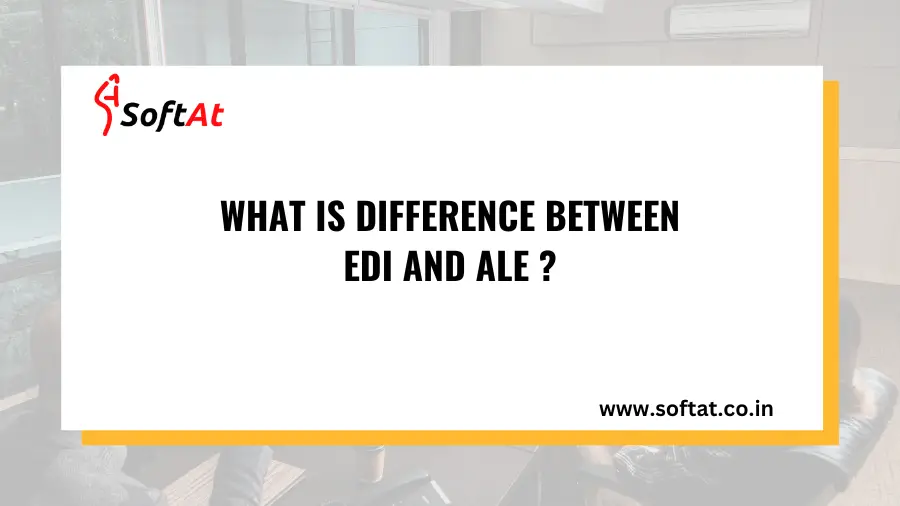In today's interconnected business world, seamless data exchange between organizations is crucial for efficient collaboration and optimized operations. Two prominent technologies facilitate this exchange: Electronic Data Interchange (EDI) and SAP Application Link Enabling (ALE). While both serve the purpose of data transfer, they cater to distinct scenarios and utilize different approaches. This blog delves into the core functionalities, applications, and key differences between EDI and ALE, empowering you to choose the right solution for your data exchange needs.
Browse More About This @ https://softat.co.in/difference-between-edi-and-ale/
Electronic Data Interchange (EDI): A Universal Language for Business
EDI acts as a standardized format for electronically exchanging business documents like invoices, purchase orders, and shipping notifications between organizations. It establishes a common language for data exchange, regardless of the specific software systems used by trading partners. Here's a breakdown of EDI's core aspects:
-
Standardized Formats: EDI utilizes predefined data formats like X12 or EDIFACT, ensuring consistent data structure and interpretation across different systems.
-
Trading Partners: EDI facilitates data exchange between independent organizations, typically utilizing a third-party Value-Added Network (VAN) or a direct connection to securely transmit and translate data.
-
Document-Centric Approach: EDI focuses on the exchange of complete business documents, ensuring all relevant information is transmitted at once.
Applications of EDI:
-
Supply Chain Management: Streamline communication and automate processes within your supply chain network by exchanging purchase orders, invoices, and shipping notifications electronically.
-
Order Processing: Expedite order fulfillment by electronically transmitting orders between your organization and your customers.
-
Inventory Management: Enhance inventory control through real-time data exchange with suppliers and distributors regarding stock levels and product availability.
SAP Application Link Enabling (ALE): Streamlining Data Exchange Within the SAP Ecosystem
ALE, on the other hand, is a technology specific to SAP systems. It facilitates data exchange between different SAP applications or between an SAP system and an external system with a custom-developed interface. Here's a closer look at ALE's key characteristics:
-
SAP-Centric: ALE operates exclusively within the SAP ecosystem, enabling communication between various SAP applications and modules within a single organization or across geographically distributed SAP landscapes.
-
Data-Centric Approach: While EDI focuses on complete documents, ALE prioritizes the exchange of specific data elements or business objects between SAP systems.
-
IDocs (Intermediate Documents): ALE utilizes IDocs (Intermediate Documents) as a standardized container format for encapsulating data during the exchange process.
Applications of ALE:
-
Master Data Management: Efficiently synchronize master data (e.g., customer, material) across different SAP systems within your organization, ensuring data consistency.
-
Sales and Distribution: Integrate your SAP ERP system with your CRM system to seamlessly exchange sales order data and customer information.
-
Production Planning: Facilitate data exchange between your SAP ERP and Manufacturing Execution System (MES) to synchronize production plans and material requirements.
Key Differences Between EDI and ALE: A Comparative Analysis
Here's a table summarizing the key differences between EDI and ALE:
| Feature | EDI | ALE |
| Purpose | Universal data exchange between businesses | Data exchange within the SAP ecosystem |
| Trading Partners | Independent organizations | SAP systems or custom-developed interfaces |
| Data Format | Standardized formats (e.g., X12, EDIFACT) | IDocs (Intermediate Documents) |
| Exchange Approach | Document-centric (complete documents) | Data-centric (specific data elements) |
| Communication Channel | Value-Added Network (VAN) or direct connection | RFC (Remote Function Call) or ports |
| Focus | Interoperability between different systems | Integration between SAP applications |
Choosing the Right Solution for Your Data Exchange Needs
The choice between EDI and ALE depends on your specific data exchange requirements:
-
For exchanging business documents with external organizations that do not utilize SAP, EDI is the ideal solution.
-
For data exchange within your SAP landscape or with custom-developed interfaces, ALE provides a robust and efficient option.
Optimizing Your Data Exchange Strategy
In some scenarios, organizations might require both EDI and ALE to cater to different data exchange needs. Here are some additional considerations for optimizing your data exchange strategy:
-
Integration with Existing Systems: Evaluate how EDI or ALE integrates with your existing software infrastructure and business processes.
-
Data Security: Ensure robust security measures are in place to protect sensitive data during electronic exchange with external parties.
-
Scalability: Choose a solution that can scale to accommodate your growing data exchange volumes.
About SoftAt PVT. LTD. :
We are a new generation IT company, focused on enterprise software implementation & Support Services.To accomplish the sustainable growth of a business, the essential factor is the industry-specific solutions that adapt to the system and its necessity. For this, SoftAt is the best place to get the Righteous solution for your business.With nearly two decades of 15 years of experience in SAP Implementation, SAP up-gradation, and SAP migration, we at SoftAt work to empower businesses with our SAP & Oracle solutions.
Contact Us: -
SoftAt Private Limited
No. A01 Second Floor Upon Bank of Baroda Kharadi,
Kharadi-Hadapsar Road, Infront of HP Petrol Pump,
Thite Vasti, Kharadi,
Pune, Maharashtra-411014
India: +91-7796611155
Email: – contactus@softat.co.in

